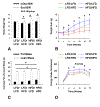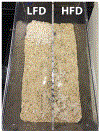Intranasal oxytocin reduces weight gain in diet-induced obese prairie voles
- PMID: 30144467
- PMCID: PMC6195438
- DOI: 10.1016/j.physbeh.2018.08.007
Intranasal oxytocin reduces weight gain in diet-induced obese prairie voles
Abstract
Oxytocin (OT) elicits weight loss in diet-induced obese (DIO) rodents, nonhuman primates and humans by reducing food intake and increasing energy expenditure. In addition to being important in the regulation of energy balance, OT is involved in social behaviors including parent-infant bonds, friendships, and pair bonds. However, the impact of social context on susceptibility to diet-induced obesity (DIO) and feeding behavior (including food sharing) has not been investigated in a rodent model that forms strong social bonds (i.e. prairie vole). Our goals were to determine in Prairie voles (Microtus ochrogaster) whether i) social context impacts susceptibility to DIO and ii) chronic intranasal OT reverses DIO. Voles were housed in divided cages with holes in the divider and paired with a same-sex animal with either the same food [high fat diet (HFD)/HFD, [low fat diet (LFD; chow)/chow], or the opposite food (HFD/chow or chow/HFD) for 19 weeks. HFD-fed voles pair-housed with voles maintained on the HFD demonstrated increased weight relative to pair-housed voles that were both maintained on chow. The study was repeated to determine the impact of social context on DIO susceptibility and body composition when animals are maintained on purified sugar-sweetened HFD and LFD to enhance palatability. As before, we found that voles demonstrated higher weight gain on the HFD/HFD housing paradigm, in part, through increased energy intake and the weight gain was a consequence of an increase in fat mass. However, HFD-fed animals housed with LFD-fed animals (and vice versa) showed intermediate patterns of weight gain and evidence of food sharing. Of translational importance is the finding that chronic intranasal OT appeared to reduce weight gain in DIO voles through a decrease in fat mass with no reduction in lean body mass. These effects were associated with transient reductions in food intake and increased food sharing. These findings identify a role of social context in the pathogenesis of DIO and indicate that chronic intranasal OT treatment reduces weight gain and body fat mass in DIO prairie voles, in part, by reducing food intake.
Keywords: (Microtus ochrogaster); Intranasal; Obesity; Oxytocin; Prairie vole.
Published by Elsevier Inc.
Figures






Similar articles
-
Chronic oxytocin administration inhibits food intake, increases energy expenditure, and produces weight loss in fructose-fed obese rhesus monkeys.Am J Physiol Regul Integr Comp Physiol. 2015 Mar 1;308(5):R431-8. doi: 10.1152/ajpregu.00441.2014. Epub 2014 Dec 24. Am J Physiol Regul Integr Comp Physiol. 2015. PMID: 25540103 Free PMC article.
-
Chronic hindbrain administration of oxytocin elicits weight loss in male diet-induced obese mice.Am J Physiol Regul Integr Comp Physiol. 2021 Apr 1;320(4):R471-R487. doi: 10.1152/ajpregu.00294.2020. Epub 2021 Jan 20. Am J Physiol Regul Integr Comp Physiol. 2021. PMID: 33470901 Free PMC article.
-
Effects of Chronic Oxytocin Administration and Diet Composition on Oxytocin and Vasopressin 1a Receptor Binding in the Rat Brain.Neuroscience. 2018 Nov 10;392:241-251. doi: 10.1016/j.neuroscience.2018.07.037. Epub 2018 Jul 31. Neuroscience. 2018. PMID: 30071278 Free PMC article.
-
Translational and therapeutic potential of oxytocin as an anti-obesity strategy: Insights from rodents, nonhuman primates and humans.Physiol Behav. 2015 Dec 1;152(Pt B):438-49. doi: 10.1016/j.physbeh.2015.05.023. Epub 2015 May 23. Physiol Behav. 2015. PMID: 26013577 Free PMC article. Review.
-
Neurochemical regulation of pair bonding in male prairie voles.Physiol Behav. 2004 Nov 15;83(2):319-28. doi: 10.1016/j.physbeh.2004.08.024. Physiol Behav. 2004. PMID: 15488548 Review.
Cited by
-
Oxytocin: A Multi-Functional Biomolecule with Potential Actions in Dysfunctional Conditions; From Animal Studies and Beyond.Biomolecules. 2022 Oct 31;12(11):1603. doi: 10.3390/biom12111603. Biomolecules. 2022. PMID: 36358953 Free PMC article. Review.
-
Vagal oxytocin receptors are necessary for esophageal motility and function.JCI Insight. 2025 May 22;10(10):e190108. doi: 10.1172/jci.insight.190108. eCollection 2025 May 22. JCI Insight. 2025. PMID: 40401525 Free PMC article.
-
Fam172a Mediates the Stimulation of Hypothalamic Oxytocin Neurons to Suppress Obesity-Induced Anxiety.Adv Sci (Weinh). 2025 Apr;12(14):e2414723. doi: 10.1002/advs.202414723. Epub 2025 Feb 17. Adv Sci (Weinh). 2025. PMID: 39960327 Free PMC article.
-
Hindbrain Administration of Oxytocin Reduces Food Intake, Weight Gain and Activates Catecholamine Neurons in the Hindbrain Nucleus of the Solitary Tract in Rats.J Clin Med. 2021 Oct 29;10(21):5078. doi: 10.3390/jcm10215078. J Clin Med. 2021. PMID: 34768597 Free PMC article.
-
Oxytocin as an Anti-obesity Treatment.Front Neurosci. 2021 Oct 13;15:743546. doi: 10.3389/fnins.2021.743546. eCollection 2021. Front Neurosci. 2021. PMID: 34720864 Free PMC article. Review.
References
-
- Striepens N, Kendrick KM, Maier W, Hurlemann R Prosocial effects of oxytocin and clinical evidence for its therapeutic potential. Frontiers in neuroendocrinology. 2011,32:426–50. - PubMed
Publication types
MeSH terms
Substances
Grants and funding
LinkOut - more resources
Full Text Sources
Other Literature Sources
Medical
Research Materials

